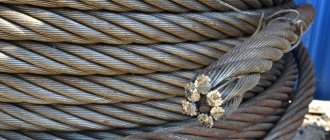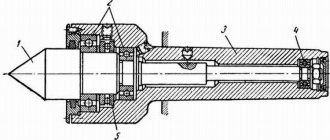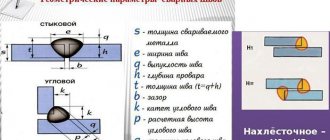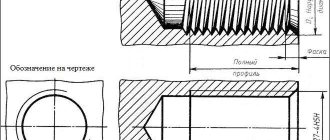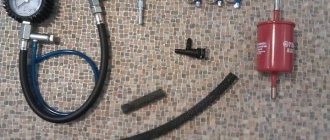OST 1 03824-75 op. V
| Continuation of the table. 3 |
| 3.12. 5% of rope seals from a batch are tested for tensile strength until failure, but not less than 2 pieces* The distance between the places where the rope is secured must be at least 300 mm. It is allowed to carry out tests on samples with a length of at least 400 mm, prepared in one batch with ropes of any length. The conditions for the strength of the seal during the tensile test before failure must be satisfied by 100% of the tested cable seals. 2.13. In the event of destruction of at least one of the tested ropes or the rope being pulled out of the seal under a load less than the breaking force indicated in Table. 3 of this standard., the doubled cat-patio of OshchiNmlS is subjected to crushing, Irp mpmi/moiJdii.tH. r^utlgptik rtontapm.l* F?NYT «SHY the entire batch of oadeyaashgmkh ropes is rejected. 2.14. Rope seals must be soaked for 3-5 minutes in gun lubricant according to GOST 19537-83, heated to a temperature of 110-120 °C. Note. Drip!, treated before sealing with a mixture consisting of 50% linseed oil according to GOST 5791-81 and 50% varnish PF-170 or PF-171 according to GOST 15907-70 with hot drying, do not impregnate with grease after sealing. During long-term storage and delivery of ropes in bulk, the seals must be soaked in lubricant. 2D5. Protection against corrosion during storage or storage is carried out with SHA1IM-201 lubricant in accordance with GOST 6267-74 within the time limits specified in the technical documentation approved in the prescribed manner. An example of an entry in the technical documentation for embedding steel ropes tala Sealing 1-OST 1 03824-75 |
Methods for sealing the ends of rope slings
Rope slings are the most common type of slings used in all industries as a flexible load-handling element. Although rope slings are the most universal, few people know all the variety of forms of their execution - from slings of the SKP (USK1) type and multi-branch slings of the 4SK type, to special types of rope slings.
There are two basic designs for rope slings: loop rope sling SKP (USK1) and ring rope sling SKK (USK2). These are the simplest types of slings; for their manufacture, a piece of rope is used, the ends of which are connected using one of the sealing methods. For the manufacture of multi-leg slings of types 1SK, 2SK, 3SK, 4SK, additional components are used. The sling itself consists of a suspension link, a directly flexible element and a gripping device. The gripping device can be hooks of various types and shapes, as well as removable load-handling devices for carrying out a certain type of work.
In the process of making slings, many methods are used to seal the ends of the rope, but the main ones for a long time have been braiding and crimping with a sleeve. When forming a loop using the braiding method, first the free end of the rope is unraveled, then the strands are woven into the body of the rope according to technology.
The number of punctures of the rope with each strand during braiding is determined depending on the diameter of the rope according to RD 10-33-93: diameter up to 15 mm - at least 4 punctures, from 15 to 28 mm - at least 5 punctures, from 28 to 60 mm - at least 6 punctures . The last puncture of each strand should be carried out with half the number of its wires (half the cross-section of the strand). After cutting off the technological allowances, the ends of the strands are sealed in such a way as to avoid unwinding of the wire and the possibility of injury to the slinger when working with the sling. The ends of the rope are sealed manually using a braiding machine; to pierce a large diameter rope, a machine with a hydraulic needle drive is used.
Sealing the ends of the rope using the crimping method requires an additional element - an aluminum or steel bushing. Bushing blanks are made from aluminum tubes and have an oval cross-section. The sleeve is put on the branch of the rope that forms a loop so that the end of the branch extends out of the sleeve after crimping by at least 2 mm. The blanks are placed in a press and compressed with a punch until a round cross-section is obtained.
To prevent premature chafing and breaking of the rope when forming a loop, a thimble made of galvanized steel is used. The thimble is a teardrop-shaped product with a groove on the outside. The shape and depth of the thimble groove corresponds to the diameter of the rope for which it is intended. The end of the rope goes around the thimble, lying in the groove and is connected to the main branch using one of the sealing methods.
One of the easiest ways to terminate the ends of rope slings is to terminate using screw clamps. The number of clamps is determined by calculation according to the standards of Gosgortekhnadzor, but their number must be at least three. The spacing of the clamps must be at least six rope diameters. The jumper of the clamp should always be located on the load-carrying side of the rope, the U-bolt of the clamp is placed on the tail of the rope. It is necessary to bend a long enough part of the rope so that the minimum required number of clamps can be placed.
Together with screw clamps, special devices - thimble clamps - can be used to form a loop on ropes of small diameter (up to 16 mm). The device is designed to quickly form the end element and facilitates the process of sealing rope ends. Going around the thimble, the ends of the rope converge at the base of the device, where they are tightened with bolts.
The most reliable methods for sealing rope ends are cast end fastenings (cable connections). The main part of the cables is the glass, which has a cast or turned structure. The rope for making jellies must be prepared: below the intended end of the jellied glass, it is braided with soft knitting wire with a diameter of 1-1.5 mm, after which the rope wire is unraveled. After initial cleaning, the wire is etched in a solution of hydrochloric acid, washed in boiling water with the addition of soda ash, and sometimes the wire is degreased in other alkaline solutions. The filling glass is cleaned in the same way and before pouring, together with the threaded rope, is heated to approximately 250–300 ° C. For pouring, pure zinc is used, as well as alloys of aluminum, zinc, lead, tin and antimony. The result is a monolithic connection that is highly durable.
In the manufacture of rope slings, wedge clamps (sleeve wedge connection) can be used, which allow for quick assembly and disassembly of connections. The connection consists of a cylindrical sleeve, inside of which a wedge insert is placed between the anchored strands of the rope. The reliability of the wedge connection is determined by the angle of inclination of the wedge and the coefficient of friction between the rope and the clamping elements.
The reliability and quality of rope slings directly depends on the components that were used during its assembly. When ordering slings, be sure to specify the method of sealing the ends of the rope and its diameter.
What materials are the clamps made from?
What is your saddle made of, wanderer?
The three main materials from which cable clamps are made are (very predictably!): stainless steel, hot-dip galvanized and zinc coated mild steel. Let's look at the example of a saddle.
Stainless steel A2 and A4. Your choice for outdoor applications and harsh conditions. Corrosion resistant out of the box.
Hot-dip galvanized steel. Feel free to take it if you want to save money. Use in unfavorable environments is limited, but it more than meets the required loads. Corrosion resistance is less than that of stainless steel.
Mild galvanized steel. By cheap means, by cheap. The material is not resistant to corrosion (however, you can’t pick off galvanized steel with your finger). If you need something for everyday life, this is the best option.
However, remember that when building highly loaded structures, you will need to check the attachment point at least once every three months to ensure that it is completely eaten up by rust. Hehe. Joke.
APPENDIX (reference). LIST OF CODES OF OKP TITS
APPENDIX 1 (for reference)
| Thimble designation () | OKP thimble code for operation at temperatures | |
| up to minus 40 °C | up to minus 60 °C | |
| 10 | 31 7829 3101 | 31 7829 3125 |
| 12 | 31 7829 3102 | 31 7829 3126 |
| 15 | 31 7829 3103 | 31 7829 3127 |
| 20 | 31 7829 3104 | 31 7829 3128 |
| 25 | 31 7829 3105 | 31 7829 3129 |
| 30 | 31 7829 3106 | 31 7829 3131 |
| 34 | 31 7829 3107 | 31 7829 3132 |
| 40 | 31 7829 3108 | 31 7829 3133 |
| 45 | 31 7829 3109 | 31 7829 3134 |
| 56 | 31 7829 3111 | 31 7829 3135 |
| 63 | 31 7829 3112 | 31 7829 3136 |
| 75 | 31 7829 3113 | 31 7829 3137 |
| 85 | 31 7829 3114 | 31 7829 3138 |
| 95 | 31 7829 3115 | 31 7829 3139 |
| 105 | 31 7829 3116 | 31 7829 3141 |
| 120 | 31 7829 3117 | 31 7829 3142 |
| 130 | 31 7829 3118 | 31 7829 3143 |
| 140 | 31 7829 3119 | 31 7829 3144 |
| 160 | 31 7829 3121 | 31 7829 3145 |
| 180 | 31 7829 3122 | 31 7829 3146 |
| 200 | 31 7829 3123 | 31 7829 3147 |
| 220 | 31 7829 3124 | 31 7829 3148 |
APPENDIX (reference). DIMENSIONS OF STEEL ROPE THINGS ACCORDING TO ISO 2262
APPENDIX 2 (for reference)
mm
| Rope diameter | |||||||
| 4 | 4,5 | 4,3 | 7 | 10 | 18 | 2,2 | 2,8 |
| 6 | 6,9 | 6,5 | 10,5 | 15 | 27 | 3,3 | 4,2 |
| 8 | 9,2 | 8,6 | 14 | 20 | 36 | 4,4 | 6,6 |
| 10 | 11,5 | 10,8 | 17,5 | 25 | 45 | 5,5 | 7 |
| 12 | 13,8 | 12,9 | 21 | 30 | 54 | 6,6 | 8,4 |
| 13 | 15 | 14 | 22,8 | 32,5 | 58,5 | 7,2 | 9,1 |
| 14 | 16,1 | 15,1 | 24,5 | 35 | 63 | 7,7 | 9,8 |
| 16 | 18,4 | 17,2 | 28 | 40 | 72 | 8,8 | 11,2 |
| 18 | 20,7 | 19,4 | 31,5 | 45 | 81 | 9,9 | 12,6 |
| 20 | 23 | 21,5 | 35 | 50 | 90 | 11 | 14 |
| 22 | 25,3 | 23,7 | 38,5 | 55 | 99 | 12,1 | 15,4 |
| 24 | 27,6 | 25,8 | 42 | 60 | 108 | 13,2 | 16,8 |
| 26 | 29,9 | 28 | 45,5 | 65 | 117 | 14,3 | 18,2 |
| 28 | 32,2 | 30,1 | 49 | 70 | 126 | 15,4 | 19,6 |
| 32 | 36,8 | 34,4 | 56 | 80 | 144 | 17,6 | 22,4 |
| 36 | 41,4 | 38,7 | 63 | 90 | 162 | 19,8 | 25,2 |
| 40 | 46 | 43 | 70 | 100 | 180 | 22 | 28 |
| 44 | 50,6 | 47,3 | 77 | 110 | 198 | 24,2 | 30,8 |
| 48 | 56,2 | 51,6 | 84 | 120 | 216 | 26,4 | 33,6 |
| 52 | 59,8 | 55,9 | 91 | 130 | 234 | 28,6 | 35,4 |
| 56 | 64,4 | 60,2 | 98 | 140 | 252 | 30,8 | 39,2 |
| 60 | 69 | 64,5 | 105 | 150 | 270 | 33 | 42 |
The electronic text of the document was prepared by Kodeks JSC and verified according to: official publication M.: Standartinform, 2007
Fixation options
It is important that the fire be reliable, otherwise the thimble will be useless. Various methods are used to form loops. For light loads, it is possible to prepare the loop using a clamp or tube.
It is important to choose and install the thimble correctly. Be sure to pay attention to the load and maximum breaking force. Products with metal cores are more durable. The reliability is also affected by the type of lay, which can be single, double or triple. Before choosing, define your goals to quickly find the right option.
Weaving a cable onto a thimble - proven methods
By itself, this simple device will not create a strong fire; you also need to skillfully braid the cable. If the expected loads are small, then you can get by with a special clamp clamp or an ordinary flattened tube. The process of creating a loop is as follows: pass a loop into the tube so that the required area for the thimble looks out from one edge, and both ends of the cable come out from the other side. From this edge you should clamp the tube with the cable in a vice, pass a metal strip into the thimble for convenience and tighten the tube. The main thing is not to overdo it, so as not to damage the cable itself.
A reinforced clamping clamp will allow you to fire even faster, but the finished structure does not look the most aesthetically pleasing, and even when working with such a cable you will cling to everything . A cable braided in a special way will look much more aesthetically pleasing and strong. To do this, you need to unravel the cable into two parts by about 30 cm, with the same number of fibers in each part. Don't forget to wear protective gloves, as metal fibers can easily damage your hands. If there is a core not made of metal fibers inside, it can be cut off - we don’t need it.
We try on the resulting halves to the thimble - it is important that they fit tightly to it and that it does not dangle after weaving is completed.
You can secure them with wire or mark the required length so as not to get lost, since rarely does anyone succeed in making a loop correctly in this way, and having achieved the result, you are unlikely to want to redo everything again. We need to knit the two halves by crossing them in such a way that the fibers on the main part intertwine with the loose fibers. Having wrapped the loose part once by hand around the main part, use a screwdriver or a metal rod to pry up the fibers and turn them deeper, mixing them with the fibers of the main part.

